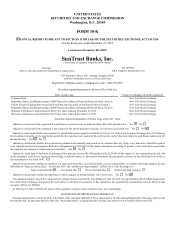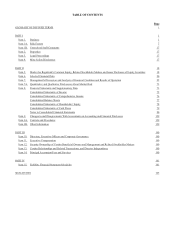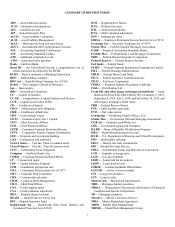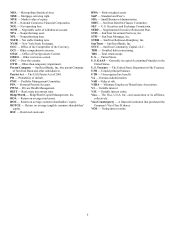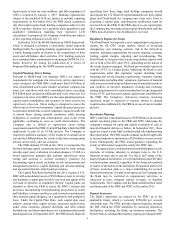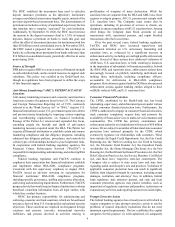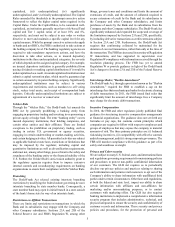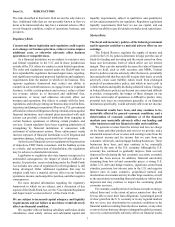SunTrust 2015 Annual Report Download - page 29
Download and view the complete annual report
Please find page 29 of the 2015 SunTrust annual report below. You can navigate through the pages in the report by either clicking on the pages listed below, or by using the keyword search tool below to find specific information within the annual report.1
PART I
Item 1. BUSINESS
General
SunTrust Banks, Inc. (“We” or “the Company”) is a leading
provider of financial services, with our headquarters located in
Atlanta, Georgia. Our principal subsidiary is SunTrust Bank
(“the Bank”). The Company was incorporated in the State of
Georgia in 1984 and offers a full line of financial services for
consumers, businesses, corporations, institutions, and not-for-
profit entities, both through its branches (located primarily in
Florida, Georgia, Maryland, North Carolina, South Carolina,
Tennessee, Virginia, and the District of Columbia), and through
other national delivery channels. The Bank provides clients with
a selection of full-, self-, and assisted-service channels, including
branch, call center, Teller Connect™ machines, ATMs, internet,
mobile, and tablet. Other subsidiaries provide capital markets,
mortgage banking, securities brokerage, and wealth
management services. At December 31, 2015, the Company had
total assets of $191 billion and total deposits of $150 billion.
We operate three business segments: Consumer Banking and
Private Wealth Management, Wholesale Banking, and Mortgage
Banking, with our functional activities included in Corporate
Other.
Additional information regarding our businesses and
subsidiaries is included in the information set forth in Item 7,
MD&A, as well as Note 20, “Business Segment Reporting,” to
the Consolidated Financial Statements in this Form 10-K.
Regulation and Supervision
BHCs are generally limited under the BHC Act to banking,
managing or controlling banks, and other activities that the FRB
has determined to be so closely related to banking as to be a
proper incident thereto. The Company, a BHC, elected to become
a financial holding company pursuant to the GLB Act, allowing
it to engage in a broader range of activities that are (i) financial
in nature or incidental to financial activities or (ii) complimentary
to a financial activity and do not pose a substantial risk to the
safety and soundness of depository institutions or the financial
system in general. These expanded services include securities
underwriting and dealing, insurance underwriting, merchant
banking, and insurance company portfolio investment, and are
subject to the Volcker Rule, Swaps Pushout Rule, and other
restrictions discussed below. The Federal Reserve regulates
BHCs under the BHC Act as umbrella supervisor, with residual
supervisory authority over “functionally regulated” subsidiaries
such as the Company's broker-dealer and investment adviser
subsidiaries. The Company's non-banking subsidiaries are
regulated and supervised by various other regulatory bodies. For
example, STRH and STIS are broker-dealers registered with the
SEC and members of FINRA. STIS is also an insurance agency
registered with state insurance commissions.
As umbrella supervisor under the GLB Act's system of
functional regulation, the FRB seeks to determine that financial
holding companies are operating in a safe and sound manner so
that their financial condition does not threaten the viability of
affiliated depository institutions. Functionally regulated
Company subsidiaries, and others, are regulated directly by
additional federal and state regulatory agencies with supervisory
authority over the particular activities of those subsidiaries. To
maintain its status as a financial holding company, the Company
and its banking subsidiary must be “well capitalized” and “well
managed” while maintaining at least a “satisfactory” CRA rating.
In the event of noncompliance, the Federal Reserve may, among
other things, limit the Company’s ability to conduct these broader
financial activities or, if the deficiencies persist, may require the
Company to divest the banking subsidiary. Furthermore, if the
Company does not have a satisfactory CRA rating, it may not
commence any new financial activities, although the Company
will still be allowed to engage in activities closely related to
banking.
The Bank is a FDIC insured commercial bank chartered
under the laws of the State of Georgia, and is a member of the
Federal Reserve System. In addition to regulation by the FRB,
the Bank and the Company are regulated by the Georgia
Department of Banking and Finance. Furthermore, the FDIC also
has certain jurisdiction over the activities of the Bank as an
insured depository institution. As a Georgia-chartered
commercial bank, the Bank's powers are limited to activities
permitted by Georgia and federal banking laws. Generally, the
Bank may engage in all usual banking activities such as taking
deposits, lending money, issuing letters of credit, currency
trading, and offering safe deposit box services.
We are also subject to supervision and regulation by the
CFPB as to our offering and provision of consumer financial
products and services. The Dodd-Frank Act authorized the CFPB
to take any action to prevent regulated entities from engaging in
unfair, deceptive, or abusive activity, under federal law, in
connection with any financial transaction with a consumer. The
CFPB also has pursued actions against non-banking entities
associated with provision of financial products.
Historically, the Company has been subject to extensive
regulation as a banking organization. More recently, the financial
regulatory landscape has been impacted by the 2010 Dodd-Frank
Act, which was enacted following the financial crisis to
restructure the financial regulatory system, restore public
confidence, and to prevent another crisis from occurring.
The Dodd-Frank Act mandates are the largest set of
regulatory changes in several decades, requiring hundreds of
rulemakings by many agencies and coordination by multiple
regulators with joint jurisdiction over the same markets and
products. The Dodd-Frank Act adds substantial, new regulation
in addition to expanding upon existing regulation, and many of
the rulemakings have yet to be proposed or finalized. As a
consequence of the Dodd-Frank Act, the FRB's supervisory
objectives now include improving U.S. financial stability, safety,
and soundness. Among other things, the Dodd-Frank Act
implements changes that affect the oversight and supervision of
financial institutions, provides for a new resolution procedure
for large financial companies, created a new agency, the CFPB
(responsible for implementing and enforcing compliance with
consumer financial laws), introduces more stringent regulatory








